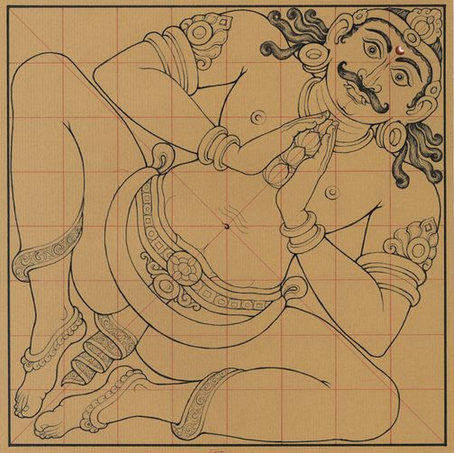Vastu Shastra is a comprehensive field of traditional Indian architecture that influences our minds, life, and destiny. It adheres to construction principles aligned with the laws of nature and its elements. Many of us are curious about the intriguing origins of Vastu Shastra—when and how did it begin? To uncover its roots, we must journey back to the prehistoric era, where it all started with the emergence of the Vastu Purusha Mandala. This Mandala represents the core philosophy of ancient Indian architectural planning.
The essence of the sacred science of Vastu is encapsulated in one secret: the Vastu Purusha Mandala. This cosmic geometrical marvel, celebrated for its mathematical beauty, has been used since ancient times to design everything from residential structures and fire altars to temples, entire villages, and cities.
According to Hindu mythology, Brahma is the creator of the cosmos. In his attempt to generate life, he conceived a cosmic being named Vastu Purusha, who was far from an ordinary man. With an insatiable appetite, Vastu Purusha devoured everything in his path.
In a matter of minutes, he grew so large that his shadow created a permanent eclipse over the entire planet. Alarmed,  Lord Shiva and Vishnu pleaded with Brahma to intervene before the ever-growing Vastu Purusha caused the eventual annihilation of the cosmos.
Lord Shiva and Vishnu pleaded with Brahma to intervene before the ever-growing Vastu Purusha caused the eventual annihilation of the cosmos.
Realizing the danger, Brahma sought assistance from the Ashta Dikpalakas, the gods and guardians of the eight cardinal directions. Together with 45 gods, including Brahma, they pinned Vastu Purusha to the ground. As Brahma held him down, the other gods seized his arms, legs, and other parts of his body. In this position, his head pointed north, and his legs pointed south.
At this juncture, Vastu Purusha began to weep and pleaded with Brahma for mercy. He reminded everyone that Brahma was his creator and that all his qualities were given by Brahma. He argued that he should not be penalized for this. Brahma, agreeing with him, decided to reward him.
Brahma transformed Vastu Purusha into an eternal creature and an indivisible entity of the Earth. He decreed that Vastu Purusha would be worshipped by mortals constructing any edifice on Earth. Those who failed to honor him would face his limitless patience and mischief. Thus, the Vastu Purusha Mandala was created.
The intricate principles of Vastu Purusha Mandala architecture underpin every construction on Earth, rooted deeply in Hindu mythology. This process starts with the excavation of a vacant plot and continues until the building is complete. As construction progresses, Brahma and 44 other deities, together forming 45 energy fields, gradually assume their designated positions.
For thousands of years, Vastu Purusha Mandala has served as the bedrock of Vastu design for temples, homes, offices, and industries. It emphasizes that the floor plan, particularly the main entrance, should align with its principles to ensure prosperity for the inhabitants.
Traditionally, the Vastu Purusha Mandala is depicted in square charts to represent the standard shape of the plot. However, for better understanding, it is often illustrated in a 360-degree format. This format features 45 gods, with 13 inner deities and 32 outer ones, each symbolizing different aspects of daily life. The traits of these deities influence the placement of rooms and other areas in the house, channeling their characteristics through the structure’s design.
The principles of Vastu Purusha Mandala architecture have evolved in harmony with geographical conditions, incorporating the use of renewable natural resources for public benefit. This approach ensures that appropriate energy sources are utilized in construction.
Key aspects of Vastu Purusha Mandala architecture include leveraging magnetic waves from the North Pole and sunlight from the East to determine building orientations. According to Vastu Chakra, structures are designed to allow the unobstructed flow of these magnetic waves and sunlight through the building.
What is the primary aim of Vastu Shastra? It emphasizes the significance of sunlight, airflow, magnetic flux, and earth energies on human well-being. The main objective of Vastu Shastra is to provide residents with maximum positive energy from these elements to lead a healthy and stress-free life. The Vastu Purusha Mandala is more than a graphical representation of 45 energy fields; it is a distribution of Vastu energy that directly interacts with our subconscious mind.
The Vastu Mandala grid is present in every piece of property, whether it is a plot, home, office, or factory, with 45 energy grids everywhere. Therefore, before creating any layouts for new construction or analyzing any existing property, casting the Vastu Purusha Mandala is essential. Each part of a building is designed according to the Vastu Purusha Mandala diagram, as each energy field has specific characteristics. While it may be challenging to follow all the guidelines of the Vastu Purusha Mandala today, especially for those living in flats, consulting a knowledgeable Vastu practitioner can help achieve the best results.